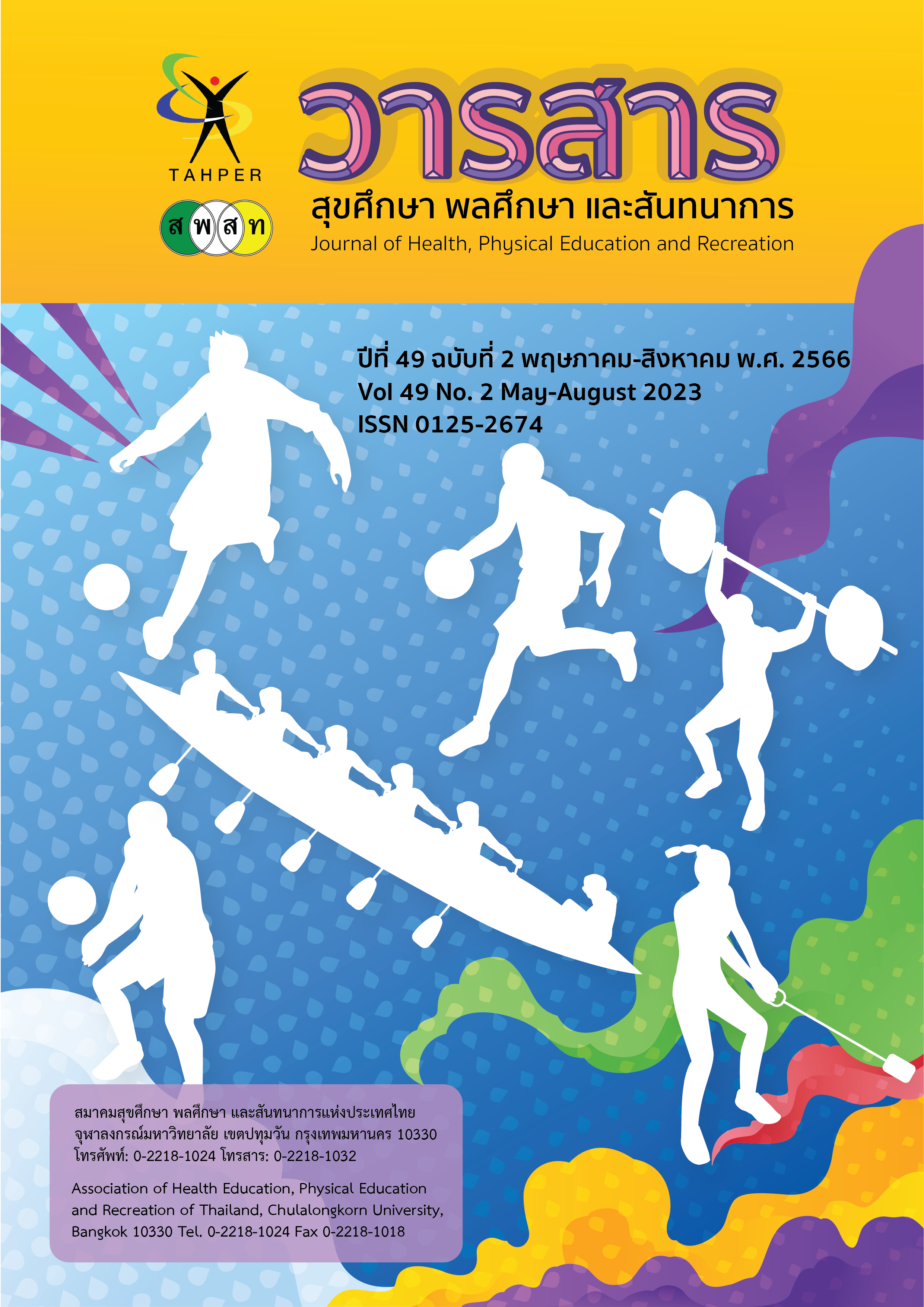Physical Activity and Risk of Non-Communicable Diseases (NCDs) Among Students of Rajamangala University of Technology Thanyaburi
Main Article Content
Abstract
The objectives of this research were 1) to study physical activity level of students of Rajamangala University of Technology Thanyaburi and 2) to study the relationship of physical activity level, gender, faculty under study, BMI risk of developing chronic non-communicable diseases (NCDs). The populations were 4,783 Rajamangala University of Technology Thanyaburis’ students who enrolled in Physical Education and Recreation Course, academic session 1/2021.The samples used in this research were 376 Rajamangala University of Technology Thanyaburis’ students who were selected by stratified random sampling. The research instrument were a shot form IPAQ (International Physical Activity Questionnaire) questionnaire and NCDs risk behaviors assessment questionnaire which developed by researcher and examined the content validity of questionnaire by 5 experts using Index of Item Objective Congruence (IOC) = 1-.071. Also, the Cronbach’s alpha coefficient used to estimate the reliability of a questionnaire was 0.80. Data were analyzed by quantification, percentage, mean, standard deviation and correlation using chi-square
The results showed that the majority of students had low physical activity (43.88%), and spent a lot of time sitting (70.21%) and about 5 hours or more (70.45%). For the risk of NCDs, the majority of students were at moderate risk (94.15%). The results of the analysis of the relationship between personal factors and physical activity levels of Rajamangala University of Technology Thanyaburi students showed that the faculty under study had a statistically significant correlation with the level of physical activity at the p-value < 0.05. Sex and body mass index were not correlated with physical activity level. The results of the analysis of personal factors Physical activity and the risk of non-communicable diseases among students of Rajamangala University of Technology Thanyaburi using Chi-square test statistics. Body mass index and physical activity level were not related to the risk of non-communicable diseases among students of Rajamangala University of Technology Thanyaburi.
Article Details

This work is licensed under a Creative Commons Attribution-NonCommercial-NoDerivatives 4.0 International License.
Critical thinking in journals is the right of the author. The Association of Health Education, Physical Education and Recreation of Thailand is not always required, to create diversity in ideas and creativity.
ความคิด ข้อวิพากษ์ในวารสารเป้นสิทธิของผู้เขียน สมาคมสุขศึกษา พลศึกษา และสันทนาการแห่งประเทศไทยไม่จำเป็นต้องเห็นชอบด้วยเสมอไป เพื่อให้เกิดความหลากหลายในความคิดและความสร้างสรรค์
References
กรมควบคุมโรค กระทรวงสาธารณสุข. (2564). COVID-19 กับ โรคไม่ติดต่อ (NCDs). สืบค้นเมื่อ 9 สิงหาคม2564, สืบค้นจาก http://www.thaincd.com/2016/media-detail.php
กรมควบคุมโรค กระทรวงสาธารณสุข. (2564). Know Your Numbers & Know Your Risks รู้ตัวเลข รู้ความเสี่ยงสุขภาพ. กรุงเทพฯ: สำนักพิมพ์อักษรกราฟฟิคแอนด์ดีไซน์.
กรมควบคุมโรค กองโรคไม่ติดต่อ. (2564). ผลกระทบจากการระบาดของโรคโควิด-19 ต่อการมีกิจกรรมทางกาย. กรุงเทพฯ: กองโรคไม่ติดต่อ กรมควบคุมโรค.
กระทรวงสาธารณสุข. (2560). แผนยุทธศาสตร์การป้องกันและควบคุมโรคไม่ติดต่อระดับชาติ 5 ปี (พ.ศ. 2560 – 2564). นนทบุรี: กระทรวงสาธารณสุข.
กองกิจกรรมทางกายเพื่อสุขภาพ. (2564). รายงานผลการวิเคราะห์สถานการณ์การส่งเสริมกิจกรรมทางกาย. สืบค้นเมื่อ 10 ธันวาคม 2564, สืบค้นจาก https://dopah.anamai.moph.go.th/webupload/8x6b2a6a0c1fbe85a9c274e6419fdd6071/tinymce/KPI2564/KPI117/25640111713.pdf
กิตติกานต์ นภากร, สมบัติ อ่อนศิริ, ณัฐกฤตา ศิริโสภณ และวิสูตร กองจินดา. (2563). กิจกรรมทางกาย พฤติกรรมการบริโภคอาหาร และความเสี่ยงต่อการเกิดโรคอ้วนในนิสิต มหาวิทยาลัยเกษตรศาสตร์ วิทยาเขตบางเขน. วารสารสุขศึกษา พลศึกษา และสันทนาการ, 46(2), 24-34.
นัฐพล ปันสกุล และศุภกาณจน์ แก่นท้าว. (2563). ความสัมพันธ์ระหว่างปัจจัยส่วนบุคคลกับระดับกิจกรรมทางกายในผู้ป่วยโรคไม่ติดต่อเรื้อรัง จังหวัดแพร่. วารสารพยาบาลสงขลานครินทร์, 40(2), 66-82.
ประกาย จิโรจน์กุล, และคณะ. (2554). กิจกรรมทางกาย พฤติกรรมการบริโภคอาหาร และความเสี่ยงต่อการเกิดโรคหัวใจและหลอดเลือดในบุคลากรมหาวิทยาลัยราชภัฏสวนดุสิต. วารสารวิจัย มสด. สาขามนุษยศาสตร์และสังคมศาสตร์, 7(1), 59-76.
วริศ วงศ์พิพิธ, ถนอมวงศ์ กฤษณ์เพ็ชร์ และสิทธา พงษ์พิบูลย์. (2563). กิจกรรมทางกายและพฤติกรรมเนือยนิ่ง : แนวทางและการประเมิน. วารสารวิทยาศาสตร์การกีฬาและสุขภาพ, 21(1), 1-21.
สถาบันวิจัยประชากรและสังคมมหาวิทยาลัยมหิดล. (2557). สุขภาพคนไทย 2557 : ชุมชนท้องถิ่นจัดการตนเองสู่การปฏิรูปประเทศจากฐานราก. นครปฐม : สถาบันวิจัยประชากรและสังคม มหาวิทยาลัยมหิดล.
สถาบันวิจัยประชากรและสังคม มหาวิทยาลัยมหิดล. (2563). สุขภาพคนไทย 2563 : สองทศวรรษ ปฏิรูปการศึกษาไทยความล้มเหลวและความสําเร็จ. นครปฐม: สถาบันวิจัยประชากรและสังคมมหาวิทยาลัยมหิดล.
สนธยา สีละมาด. (2557). กิจกรรมทางกายเพื่อสุขภาวะ. กรุงเทพฯ: สำนักพิมพ์แห่งจุฬาลงกรณ์มหาวิทยาลัย.
สำนักงานกองทุนสนับสนุนการสร้างเสริมสุขภาพ. (2563). กลุ่มโรค NCDsที่คุณสร้างเอง. สืบค้นเมื่อ 10 ธันวาคม 2564, สืบค้นจาก https://www.thaihealth.or.th/ncds/
สำนักงานคณะกรรมการส่งเสริมการลงทุน บีโอไอ. (2564). ข้อมูลทั่วไปด้านประชากร. สืบค้นเมื่อ 9 สิงหาคม 2564, สืบค้นจาก https://www.boi.go.th/index.php?page=demographic&language=th
สำนักเลขานุการของคณะกรรมการยุทธศาสตร์ชาติ. (2561). ยุทธศาสตร์ชาติ 2561-2580 (ฉบับราชกิจจานุเบกษา). สืบค้นเมื่อ 9 สิงหาคม 2564, สืบค้นจาก https://sto.go.th/th/about/policy/20-year-strategic-plan
สรชา ผูกพันธ์. (2559). ความรู้ ทัศนคติ และพฤติกรรมเสี่ยงต่อการเกิดกลุ่มโรคติดต่อเรื้อรังของนิสิตนักศึกษา มหาวิทยาลัยของรัฐในกรุงเทพมหานคร. ปริญญาศิลปศาสตรมหาบัณฑิต (คหกรรมศาสตรศึกษา) มหาวิทยาลัยเกษตรศาสตร์.
Cronbach, L. J. (1990). Essentials of psychological testing. (5th ed.). New York : Harper Collins. Publishers.
World Health Organization. (2011). Global Recommendations on Physical Activity for Health 18-64 years old. Geneva. Retrieves from http://www.who.int/dietphysicalactivity/
Yamane, Taro. (1973). Statistics: An Introductory Analysis. (3rd Ed.). New York. Harper and Row Publications.


